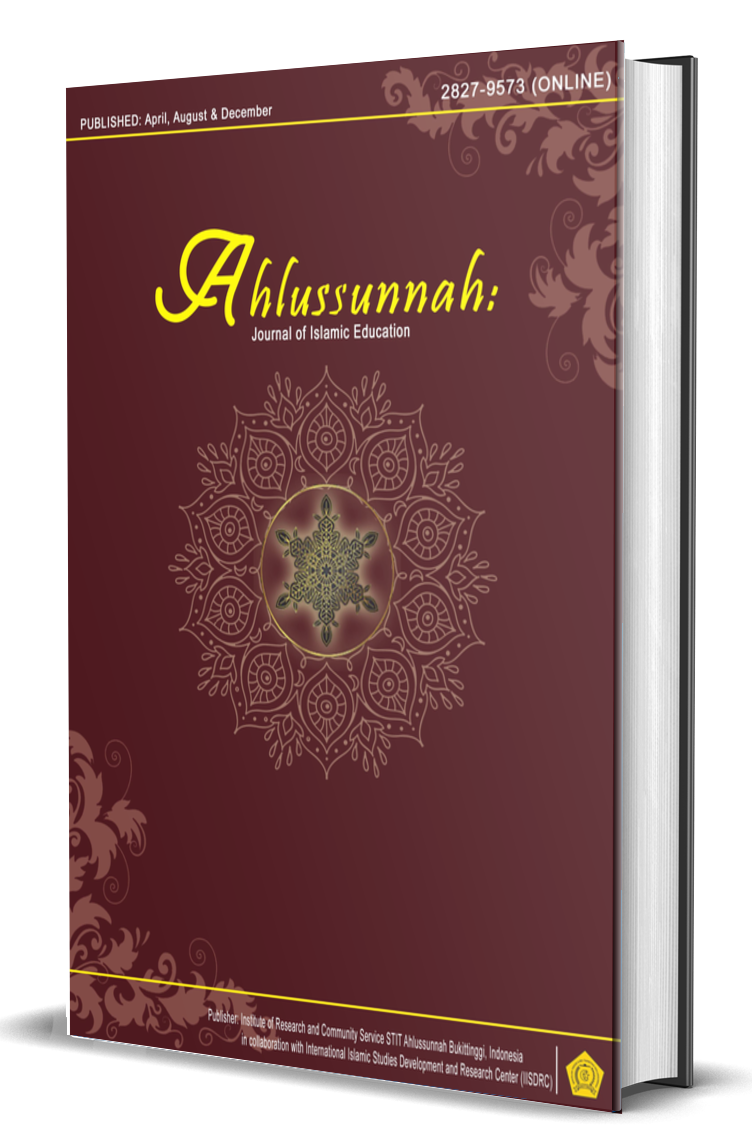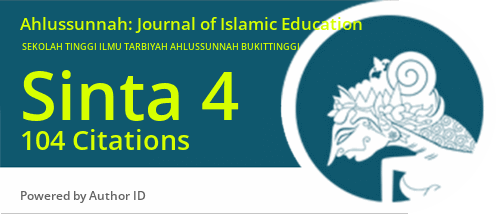Teacher Efforts in Increasing Student Interest in Reading the Quran
DOI:
https://doi.org/10.58485/jie.v1i3.184Keywords:
Teacher business, Islamic religious education, interests, QuranAbstract
This research uses descriptive qualitative methods. Data was collected through observation, interviews, and documentation. The data analysis uses the following steps, namely data reduction, data display, and drawing conclusions. The results of the analysis show the condition of interest in reading the Al-Quran of class VII students at the Legusa Community Learning Activity Center, Luak District, Lima Puluh Kota. Fifty Cities showed results that students' interest in reading the Quran was still low. The efforts carried out by Islamic Religious Education teachers are quite diverse. Starting from motivating students to be enthusiastic and happy when studying the Quran. Gives an overview of the virtues of reading the Quran. Give rewards to students who are serious about studying. Tadarus at the beginning of learning. Factors that influence Islamic Religious Education teachers in increasing interest in reading the Quran are factors within students, namely physiological and psychological factors in children. Factors from outside the student, the student's family, and their environment. lack of available lesson hours. This can be seen in students who do not repeat lessons at home. Because most of them have jobs while studying. Apart from that, there is also a lack of support from the family for them to study. So they really need to continue to be motivated and encouraged to be enthusiastic about learning.
Downloads
References
Amirudin, A., & Muzaki, I. A. (2019). Life Skill Education and It’S Implementation in Study Programs Islamic Religious Education. Jurnal Tarbiyah, 26(2). https://doi.org/10.30829/tar.v26i2.485
Ando, H., Cousins, R., & Young, C. (2014). Achieving Saturation in Thematic Analysis: Development and Refinement of a Codebook. Comprehensive Psychology, 3, 03.CP.3.4. https://doi.org/10.2466/03.cp.3.4
Arifin, Z. (2018). Al-Ghazali’s Thought of Islamic Education And it’s Relevance with the Modern Education. Khalifa: Journal of Islamic Education, 2(1), 1. https://doi.org/10.24036/kjie.v2i1.18
Ashidiqi, M. N. A., Rohmatiah, A., & Rahmah, F. A. (2019). Youtube Free Quran Education As a Source of Islamic Education Learning Materials and Media. Khalifa: Journal of Islamic Education, 3(2), 126. https://doi.org/10.24036/kjie.v3i2.27
Aziz Hussin, A. (2018). Education 4.0 Made Simple: Ideas For Teaching. International Journal of Education and Literacy Studies, 6(3), 92. https://doi.org/10.7575/aiac.ijels.v.6n.3p.92
Backes, M., Holz, T., Kollenda, B., Koppe, P., Nürnberger, S., & Pewny, J. (2014). You can run but you can’t read: Preventing disclosure exploits in executable code. Proceedings of the ACM Conference on Computer and Communications Security, 1342–1353. https://doi.org/10.1145/2660267.2660378
Bayat, A. (2017). 87. Islam and Democracy: What is the Real Question? Democracy, 502–515. https://doi.org/10.7312/blau17412-106
Chanifah, N., Hanafi, Y., Mahfud, C., & Samsudin, A. (2021). Designing a spirituality-based Islamic education framework for young muslim generations: a case study from two Indonesian universities. Higher Education Pedagogies, 6(1), 195–211. https://doi.org/10.1080/23752696.2021.1960879
Daheri, M. (2022). Religious Moderation, Inclusive, and Global Citizenship as New Directions for Islamic Religious Education in Madrasah. Nazhruna: Jurnal Pendidikan Islam, 5(1), 64–77. https://doi.org/10.31538/nzh.v5i1.1853
Doyle, L., McCabe, C., Keogh, B., Brady, A., & McCann, M. (2020). An overview of the qualitative descriptive design within nursing research. Journal of Research in Nursing, 25(5), 443–455. https://doi.org/10.1177/1744987119880234
Ebrahimi, M., & Yusoff, K. (2017). Islamic Identity, Ethical Principles and Human Values. European Journal of Multidisciplinary Studies, 6(1), 325. https://doi.org/10.26417/ejms.v6i1.p325-336
Estiani, S. W., & Hasanah, E. (2022). Principal’s Leadership Role in Improving Teacher Competence. Nidhomul Haq : Jurnal Manajemen Pendidikan Islam, 7(2), 229–241. https://doi.org/10.31538/ndh.v7i2.2281
Febriani, A., Sindi, N. F., Amanda, L. G., Rahman, R. A., & Putri, A. R. (2022). Seven Steps of the Implementation of Mind Mapping Method in Learning of Islamic Education. Khalifa: Journal of Islamic Education, 6(1), 24. https://doi.org/10.24036/kjie.v6i1.194
Findlay, A. M., King, R., Smith, F. M., Geddes, A., & Skeldon, R. (2012). World class? An investigation of globalisation, difference and international student mobility. Transactions of the Institute of British Geographers, 37(1), 118–131. https://doi.org/10.1111/j.1475-5661.2011.00454.x
Glenton, C., Colvin, C. J., Carlsen, B., Swartz, A., Lewin, S., Noyes, J., & Rashidian, A. (2013). Barriers and facilitators to the implementation of lay health worker programmes to improve access to maternal and child health: Qualitative evidence synthesis. Cochrane Database of Systematic Reviews, 2013(10). https://doi.org/10.1002/14651858.CD010414.pub2
Grissom, J. A., Loeb, S., & Master, B. (2013). Effective Instructional Time Use for School Leaders: Longitudinal Evidence From Observations of Principals. Educational Researcher, 42(8), 433–444. https://doi.org/10.3102/0013189X13510020
Hamidi, H., & Chavoshi, A. (2018). Analysis of the essential factors for the adoption of mobile learning in higher education: A case study of students of the University of Technology. Telematics and Informatics, 35(4), 1053–1070. https://doi.org/10.1016/j.tele.2017.09.016
Hanich, J., Wagner, V., Shah, M., Jacobsen, T., & Menninghaus, W. (2014). Why we like to watch sad films. The pleasure of being moved in aesthetic experiences. Psychology of Aesthetics, Creativity, and the Arts, 8(2), 130–143. https://doi.org/10.1037/a0035690
Haug, P. (2017). Understanding inclusive education: ideals and reality. Scandinavian Journal of Disability Research, 19(3), 206–217. https://doi.org/10.1080/15017419.2016.1224778
Hopkins, E. J., & Weisberg, D. S. (2017). The youngest readers’ dilemma: A review of children’s learning from fictional sources. Developmental Review, 43, 48–70. https://doi.org/10.1016/j.dr.2016.11.001
Ismail, I. (2016). Character Education Based on Religious Values: an Islamic Perspective. Ta’dib: Jurnal Pendidikan Islam, 21(1), 41–58. https://doi.org/10.19109/td.v21i1.744
Jafari, A., & Süerdem, A. (2012). An analysis of material consumption culture in the Muslim world. Marketing Theory, 12(1), 61–79. https://doi.org/10.1177/1470593111424184
Muswara, A., & Zalnur, M. (2019). Design of Character Building for Learners in Boarding Schools in West Sumatera. Khalifa: Journal of Islamic Education, 3(1), 1. https://doi.org/10.24036/kjie.v3i1.17
O’Neill, J., Tabish, H., Welch, V., Petticrew, M., Pottie, K., Clarke, M., Evans, T., Pardo Pardo, J., Waters, E., White, H., & Tugwell, P. (2014). Applying an equity lens to interventions: Using PROGRESS ensures consideration of socially stratifying factors to illuminate inequities in health. Journal of Clinical Epidemiology, 67(1), 56–64. https://doi.org/10.1016/j.jclinepi.2013.08.005
Ogrinc, G., Davies, L., Goodman, D., Batalden, P., Davidoff, F., & Stevens, D. (2015). SQUIRE 2.0 (Standards for QUality Improvement Reporting Excellence): Revised publication guidelines from a detailed consensus process. Journal of Continuing Education in Nursing, 46(11), 501–507. https://doi.org/10.3928/00220124-20151020-02
Orba Manullang, S., Mardani, M., & Aslan, A. (2021). The Effectiveness of Al-Quran Memorization Methods for Millennials Santri During Covid-19 in Indonesia. Nazhruna: Jurnal Pendidikan Islam, 4(2), 195–207. https://doi.org/10.31538/nzh.v4i2.1334
Pulido-Martos, M., Augusto-Landa, J. M., & Lopez-Zafra, E. (2012). Sources of stress in nursing students: A systematic review of quantitative studies. International Nursing Review, 59(1), 15–25. https://doi.org/10.1111/j.1466-7657.2011.00939.x
Ranney, M. L., Meisel, Z. F., Choo, E. K., Garro, A. C., Sasson, C., & Morrow Guthrie, K. (2015). Interview-based Qualitative Research in Emergency Care Part II: Data Collection, Analysis and Results Reporting. Academic Emergency Medicine, 22(9), 1103–1112. https://doi.org/10.1111/acem.12735
Rotman, D., Preece, J., Hammock, J., Procita, K., Hansen, D., Parr, C., Lewis, D., & Jacobs, D. (2012). Dynamic changes in motivation in collaborative citizen-science projects. Proceedings of the ACM Conference on Computer Supported Cooperative Work, CSCW, 217–226. https://doi.org/10.1145/2145204.2145238
Rounding, K., Lee, A., Jacobson, J. A., & Ji, L. J. (2012). Religion Replenishes Self-Control. Psychological Science, 23(6), 635–642. https://doi.org/10.1177/0956797611431987
Sartika, F., Ritonga, M., & Rasyid, A. (2020). Implementation of Islamic Religious Education in Madrasah Ibtidaiyah During Covid-19 Pandemic. Khalifa: Journal of Islamic Education, 4(2), 97. https://doi.org/10.24036/kjie.v4i2.95
Soga, M., & Gaston, K. J. (2016). Extinction of experience: The loss of human-nature interactions. Frontiers in Ecology and the Environment, 14(2), 94–101. https://doi.org/10.1002/fee.1225
Thompson, M. A., Mugavero, M. J., Rivet Amico, K., Cargill, V. A., Chang, L. W., Gross, R., Orrell, C., Altice, F. L., Bangsberg, D. R., Bartlett, J. G., Beckwith, C. G., Dowshen, N., Gordon, C. M., Horn, T., Kumar, P., Scott, J. D., Stirratt, M. J., Remien, R. H., Simoni, J. M., & Nachega, J. B. (2012). Guidelines for improving entry into and retention in care and antiretroviral adherence for persons with HIV: Evidence-based recommendations from an international association of physicians in AIDS care panel. Annals of Internal Medicine, 156(11), 817–833. https://doi.org/10.7326/0003-4819-156-11-201206050-00419
Veletsianos, G., & Navarrete, C. C. (2012). Online social networks as formal learning environments: Learner experiences and activities. International Review of Research in Open and Distance Learning, 13(1), 144–166. https://doi.org/10.19173/irrodl.v13i1.1078
Zulmuqim, Z. (2017). The Existence of Pesantren, Kiai and Kitab Kuning learning as the Main Element of Islamic Education in Indonesia. Khalifa: Journal of Islamic Education, 1(2), 113. https://doi.org/10.24036/kjie.v1i2.9
Downloads
Published
How to Cite
Issue
Section
License
Copyright (c) 2022 M Yemmardotillah, Muhammad Hafizh, Muhammad Faiz, Hafizul Hamdi

This work is licensed under a Creative Commons Attribution-ShareAlike 4.0 International License.
Creative Commons Attribution 4.0 (CC BY)











